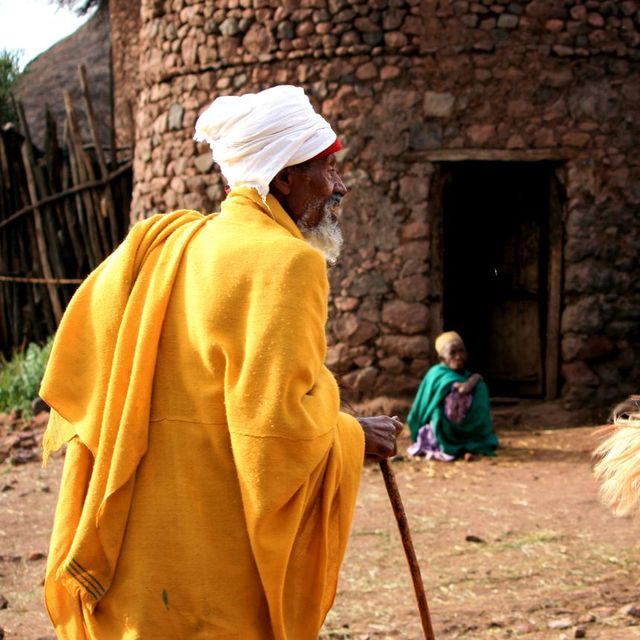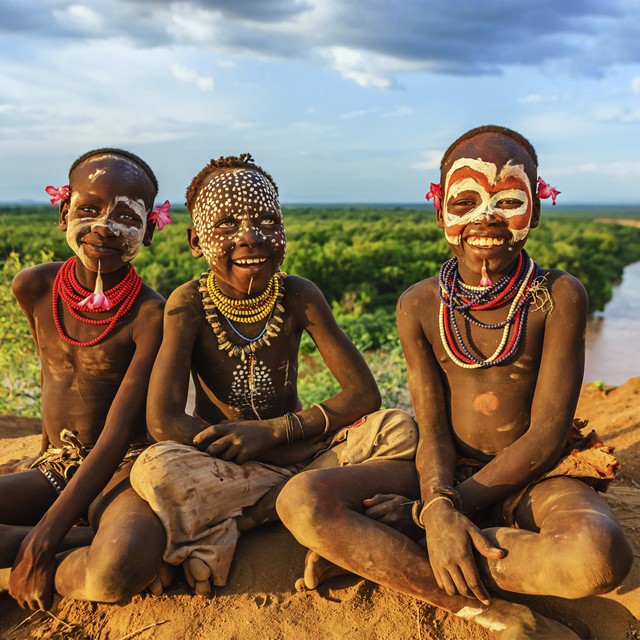Oblivious to a world beyond their own until the 1960s/70s, the tribes of the Omo Valley in Ethiopia and their traditions have remained intact and untouched by the modern world. The valley has been home to these numerous communities for hundreds of years, and though many tribes share traditions, each tribe has their own distinct culture. Between the tribes, over 47 different languages are spoken, including languages that are endemic to the Omo Valley. Many are pastoral farmers, and cattle have a great importance for several of the tribes listed here, as they are not only providers of nutrition but they are also a symbol of wealth. Don’t be alarmed if you see the villagers carrying AK-47s; they have replaced the spears we might typically associate African tribes with, and family members who own one are more highly respected as a result. Trips that coincide with the changing market days help to make the adventure particularly memorable, as neighbouring tribes come together in a colourful collective to sell their traditional crafts. The markets at Dimeka, Key Afar, and Turmi are considered some of the best, although there are many more to choose from, and here you will find the Hamer, Karo, and Dassanech tribes with their unique products.
Much like the people who live there, the landscape of the Omo Valley is full of variety. The Omo and Mago rivers, which are very important for sustaining the tribes who live along their banks, flow from the luscious mountainous areas, down to the boundless and dry savannah plains. However, the construction of the large Gilgel Gibe III hydroelectric dam on the Omo river has disrupted its natural flow and has consequently affected many of the tribes’ food sources and ways of life. In contrast, the Lower Valley region remains a protected area for its historical and anthropological value as it has yielded key clues that have developed our understanding of the evolution of man. It is the site of numerous fossil and archeological discoveries (including fragments of Australopithecus), and has been designated as a UNESCO World Heritage site.
Hamer Tribe
A day spent with the Hamer people is a colourful and captivating adventure. Highly concerned with beautification and bodily modification, they have several traditions that revolve around making themselves look more attractive, as well as highlighting their bravery. The Hamer people typically stand out from the other tribes because of the women’s red hair, twisted and painted with ochre to create this distinctive look. Their fashion-conscious style doesn’t end there; they can also be seen wearing goatskin clothing decorated with cowrie shells, and their arms and necks are adorned with a multitude of metal or colourful beaded bracelets and necklaces. Since the Hamer men are also polyamorous and can marry several women, the first wife wears a particular necklace, called a binyere, that denotes her special status. Like many of the other Omo tribes, both men and women deliberately scar their bodies; for the men it is a mark of the number of kills they have made, whilst for women it is done to make themselves more beautiful. Not only are cows a symbol of wealth for families here, but the Hamer people have an exhilarating tradition of bull jumping, which frequently attracts visitors to this specific tribe. An event that signals when a man is ready for marriage, he must run over the backs of at least 8 cows without falling off, in order to prove his worth.
Karo Tribe
On the eastern banks of the Omo river you will discover the Karo tribe: one of the smaller valley tribes, whose artistic and aesthetic practices are incredibly important in their daily lives. The intricate chalk paint designs that decorate the bodies of the Karo tribespeople immediately reflect both their intimidating and celebratory purpose. Designs vary, but popular ones mirror the patterns of the Guinea Fowl’s feathers, or frequently handprints are printed all over the body, and are worn during special life events, as well as acting as an aggressive deterrent to rival tribes. In fact, lots of importance is placed on how each of the tribal members decorate their body in more permanent methods. Women deliberately scar their chests as this as viewed as more attractive, and similarly the men mark their bodies with a scar for each time they kill an animal or an enemy, in order to highlight their bravery. A Karo man might also make and wear a grey headdress, complete with large ostrich feathers, as another symbol of his strong masculinity.
Mursi Tribe
Recognisable by the women’s large and colourful lip plates, the Mursi tribe and their unique traditions are consistently an intriguing cultural experience for visitors. Achieved by piercing the lip of the unmarried woman and gradually stretching it through the use of larger plates, it is certainly a culture very different from our own. Thought to have originated as a way of making themselves look uglier to European slave traders and therefore evade capture, these bodily modifications are now a source of pride for the women. In fact, the larger her lip plate, the more value she is given as a bride. Cows are very important as they are considered a form of currency, and a marriage arrangement involves the man giving a large sum to his future bride’s family. This pastoral tribe also have another extreme custom, called “donga”. It is a violent activity that involves unmarried men painting their bodies with white patterns before beating other with long sticks until one opponent is eliminated. Considered a display of the men’s masculinity, a group of awaiting young women then decide between themselves who will get to marry the winner.
Although an incredibly interesting tribe, due to ongoing issues with the ethical management of tourist activities in connection with the Mursi tribe, Travel The Unknown will not be taking clients here until improvements have been made.
Suri/Surma Tribe
Despite being a more reclusive tribe, Suri, or Surma, people share a lot of similarities with the Mursi tribe, including the use of the lip plates and donga fighting. Similar to the lip plate tradition, women may also choose to elongate and enlarge their earlobes as a form of beautification. Also of great importance is the bodily scarification the men partake in, as a symbol of the number of opponents they have killed. However, the Suri tribe also participate in less painful practices for decorating their bodies, as seen by the delicate and brightly coloured flower headbands men and women wear during important ceremonies. In addition, the tribe frequently use crushed flowers, leaves, and rocks to create paints which they then apply to their bodies. You will undoubtedly experience the strong sense of community present here, which is aided by the tribe’s living situation as many generations typically live together under one roof. Like many of the other Omorate tribes, cattle have incredibly high importance amongst the tribespeople, and they are kept for their economic value, as well as the nourishment value they provide.
Dassanech
The name “Dassanech” literally translates to “people from the delta” and this tribe is as much a part of the landscape of the southern Omo valley, as the rivers that run through it. Whilst they live on the northern shores of Lake Turkana, drought is a common problem that disrupts the lives of these people. Like many of the other tribes discussed, the Dassanech tribe are agro-pastoralists, relying on cows and crops as their primary sources of income and food. They have also become adept at fishing, given their close proximity to the Omo river. The Dimi ceremony is one of the tribe’s most important events and is an enjoyable one for visitors to attend as the entire community unites to bless the first-born daughters. At sunset, the men dance through the village and down towards the river, wearing animal skins and having decorated their bodies with painted patterns and their hair with extravagant ostrich feathers. They are followed by the women, and the night is filled with captivating sounds and sights of chanting and dancing as the ceremony draws to a close.
Check out our tours with these unique experiences below
Prefer to do a tailor-made itinerary where you can choose your unique experiences and build your perfect trip?
Click here to contact us today.


